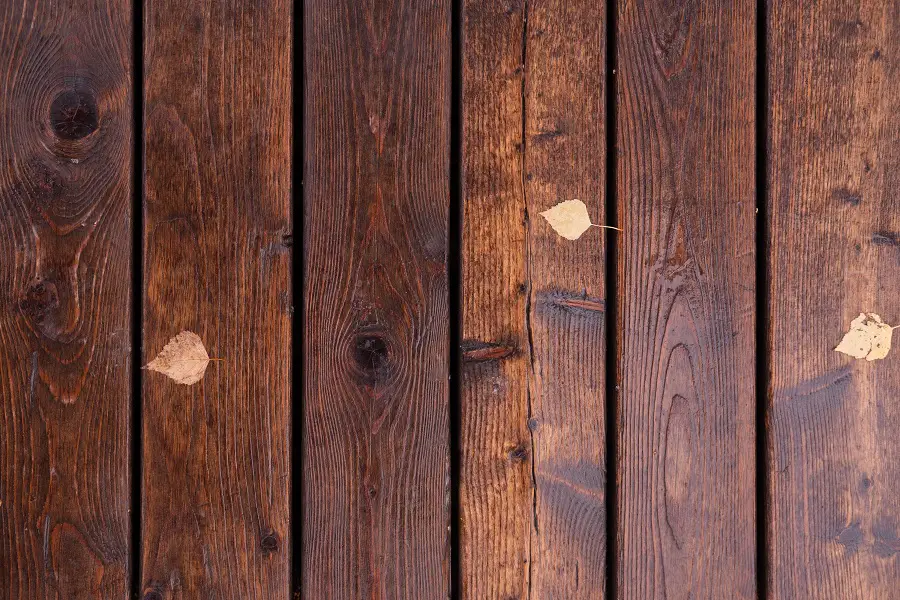Staining often results in a much improved appearance of the wood, enhancing its natural design. However, the process can be challenging and requires understanding, patience and often a little skill to solve. Stains, uneven coloring or coloring that is different from the sample spoil the look of a piece of furniture or a piece of wood that has been worked on. Find full information on how to stain for a stain-free look here. In this article, we'll focus on some of the most common problems in the wood staining process, offering practical solutions to overcome them.

Issue #1 Uneven wood staining
One of the common problems is when wood is colored differently, with some portions being lighter in color than others. This can be caused by the natural variability of the wood, uneven absorption of the stain, or misapplication. To prevent this problem, it is advisable to carefully select the wood with color and texture in mind, and when appropriate, use bleaches or bleaching substances to even out the color. Proper cleaning of the wood surface prior to stain application is also essential to ensure even absorption.
If proper wood selection is not possible, one solution may be to bleach the wood with substances such as perhydrol, sodium hypochlorite (laundry bleach) or soda. Find here several methods of bleaching or decolorizing wood. In general, after bleaching, the surface must be washed to remove residues which may later react with the colorant.
Another common problem is different absorption due to the variability of pores and wood texture. To remedy this, insulating the wood surface with special insulators or diluted solution of aracet can prevent uneven absorption. No film should form after applying the insulators. The insulator penetrates into the wood, hardens inside and reduces absorption. After the insulator has dried, the surface of the wood should be sanded before applying the wood stain.
Uneven coloring can also be remedied after drying or priming by using a coloring solution also known as standardizing. It is an acetone-based varnish, identical in color to the color applied, which is applied in a very thin coat over the colored and dried surface or after the first coat of primer/lacquer, dried and sanded. Uniformizer is applied by spraying. After drying, continue with the next coat of primer or the last coat of varnish.

Issue #2 Wi wipe-on stain dries too quickly and cannot even out color
This problem sometimes arises when applying water-based and resin-containing baths, called glaze. It happens because of the small quantity applied or because the solvent is very volatile and does not provide the necessary time for wiping. The result is an uneven color that is too light or, on the contrary, much too dark
For light colors, if the stain is water-based, the solution is simple. Re-apply the stain, this time in a larger quantity, and wipe it so that uniformity is achieved. If glazes have been applied, dilute slightly with a retarding thinner (which evaporates more slowly) before reapplying. This will slow drying and allow sufficient time for wiping.
If the color is darker than desired, it will need to be removed, returning the wood to its original color. To do this, wipe the surface very well with thinner, then sand with coarse sandpaper (80-100). If glazes have been applied, you may need to paint stripper to remove it. After coarse sanding, the surface shall be sanded with a finer grain, but suitable for the wood species, before re-application.
Issue #3 Parts with fiber ends (strands) close too much in color
As a result of milling solid wood, places with agglomeration of fiber ends appear. In door frames or profiled planks, these areas are also called 'racks'. Here the absorption of the wood grain is higher and the resulting color is darker than the rest of the surface.
The defect can be avoided by limiting absorption. Limiting can be done by sanding these edges with a finer grit and spraying smaller, successive amounts of the stain or by applying an insulator, as in the above situations. Excess quantity and wiping should be avoided.
If the defect has appeared, the recommendation is to insulate the area around the grain with paper tape, wipe with nitro thinner or a mixture of technical spirit and acetone and sand it, first with coarse paper, then with finer. Once you reach wood or a lighter color, resume dabbing by applying small amounts.

Issue #4 #4 The sample highlights defects from mechanical machining or handling
Small dents, scratches or marks caused by a faulty tool or tooling that are not visible before the wood is finger-jointed can occur as a result of mechanical processing and handling. It happens because the sanding of the wood before staining has not been done carefully enough or the defects have been generated during this phase by using the wrong grits or tools. All of these will show up when the stain is applied and will be emphasized by the stain.
When such problems occur, it is very difficult to repair just the defect. It is almost impossible to sand and re-brush just that area without differences from the rest of the surface. In most cases the whole surface has to be repainted. It is therefore preferable to find the defect before staining. This can be done by wiping the entire surface with water or thinner beforehand.
When water is used we have the advantage of no odor, but the fiber will pick up more and will have to be sanded again. Before applying the polishes the surface must dry, especially if it is a solvent based polish. If solvent is used, it will be unpleasant to smell, but we have the advantage of removing any greasy stains that may have appeared during handling. Another advantage is the reduced fiber lift, as the polish can be applied without the need for further sanding.
Issue #5 When sanding the primer, the color on the edges was also removed
While sanding the primer (sanding between coats), the color on some edges may be removed and the wood becomes visible. This can be caused by sanding paper with too stiff a backing that does not mold to the shape of the object, carelessness or overzealousness. The use of abrasive sponges reduces the risk of the defect, but does not eliminate it completely.
Remediation is done by wiping the edge with a stain or colored primer (with the same stain). If you apply the stain, wipe off the excess immediately so as not to stain the adjacent areas. If colored primer is chosen, allow to dry and then lightly sand the area to level the surface. Then, in both cases, apply at least one more protective coat (varnish or primer and varnish) over the entire surface.
The spots can also be repaired using special markers available from paint and varnish suppliers or DIY stores. The disadvantage here is that there are a limited number of colors.

Issue #6 The color on the final object is different from the sample color
Even if the same stain is used as for the agreed sample, the final color may be lighter, darker, or slightly different in hue. This may be caused by sanding the wood with too fine or too coarse paper, applying too little or too much wood stain, using a different solvent or using it without mixing it thoroughly in the original packaging, using different varnishes to those with which the sample was coated.
When the color is lighter or darker, things are clear. If it's light, it needs to be darkened, and if it's too dark, it needs to be stripped, sanded and recolored. The color is not only checked at the end but also in the intermediate stages to make the fix easier. My recommendation is to have a sample to see what the color looks like after each stage. The color can be darkened with a coat of evener applied over the primer or at the end, a thin coat of colored varnish. It is preferable that the defect is resolved by the final coat of varnish because a colorless varnish has a different transparency than a colored one. Different methods for stripping a surface, find here.
The problem is compounded when the shade differs slightly, even if the same stain was used. This can happen if the stain is not mixed very well before use, diluted with a different thinner than usual, or the final varnish is changed. Coloring solutions contain pigments that have different weights and deposit differently. If not mixed well, some may remain at the bottom of the packaging and the color will be changed. Also, some colorants are not soluble in all solvents. If the diluent is changed, some may become insoluble, settle and change color. The final color can also be changed by the varnish. Some varnishes have a slight brownish tint (nitrocellulose varnish, for example) which changes the color of the stain, especially if it is light.
It's hard to repair a changed shade and sometimes has to be stripped and redone. However, if the shade is very slightly different and you discover this after applying the primer, try repairing using a leveling bath with a slight complementary shade. For example, if the surface is slightly reddish, add a little green in the evener and vice versa, red if the color bleaches into the green. Add a little black to darken the color and reduce brightness.
Consider the light when checking the color. The type of light plays a very important role in how colors look. Cold, neon light makes colors appear cooler, with a slight blue tint, while warm light gives the color a yellowish tint. And if the color is warm and you check a blue-tinged surface, shades of green or turquoise appear.
I hope you find the above information useful. As always, additions are welcome. And if you have any questions or queries, please leave them below in the space provided. I will be sure to reply.




































Add comment